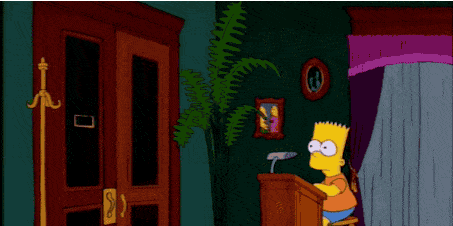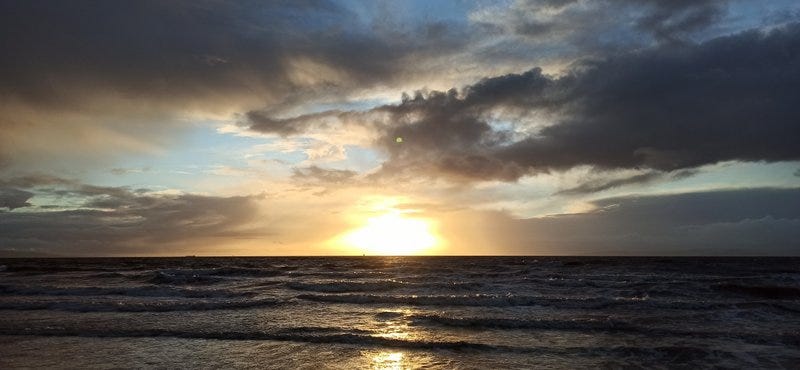Hello! This is Everything Is Amazing, a rather odd newsletter about curiosity, science and asking daft questions - like If I see pillars of light in the sky, are they really there? and Why do all our maps point north?
(Spoiler answers: “Nope, except kind of, but not really!” and “Because some people are really awful!”)
Some happy news, or at least I hope you regard it so: after clearing a backlog of non-newsletter work, and after all the megaflood-related madness of February, I am now, finally, in a position to make EiA my main writing gig! (Hooray! Pinch me.)
To that end, I’m getting back to sending this thing out more or less twice a week: on a Tuesday (or maybe a Wednesday morning), and on a Friday (or perhaps on Saturday morning). Let’s see how that goes.
Before we start, a few wonders from around the Web:
- check out this amazing DIY camera obscura (hat-tip to Andy Palmer):
- here’s a reminder no pet-lover will need: we are nothing but furniture for our animal overlords.

- here is a comprehensive answer to the excellently daft question, “Hey, how could I fossilize myself?” (It contains the attention-grabbing line: “He also had news for me about which part of my pale outer body was most likely to be visible in future rocks… my genitals.”)
- …and if you could do with a proper break right now, how about running a post office in Antarctica?
OK. Onto today’s topic, which is a two-parter for free and paid subscribers - and an exercise in stupidity.
As I suggested here, I think 2022 is an excellent year for behaving stupidly:
“No, not the aggressive, self-righteous kind that makes no effort to consider the welfare of others (I think we’ve had quite enough of that stuff over the last few years) - but the silly, playful variety that’s always looking for a wry angle, even on the serious issues. The kind that can wake a room up, in almost entirely the good way. The kind that makes folk laugh, then sticks in their memory in a way nothing else does. The kind that can finally make people think.”
As I’ve said before, curiosity is there to drive us towards what we don’t yet know we don’t know. (Famously, former US Secretary of Defense Donald Rumsfeld defined this as “unknown unknowns” - which is known in psychology as part of the Johari Window.)
But this creates a logical problem. If you don’t even know a critical gap in your knowledge of the world exists, what rational strategy can you pursue to discover it?
This is a real brain-twister for anyone wanting to “optimise” their curiosity, in the way that productivity and time management have been treated in the aspirational business world. What’s the system here? What are the rules of this game and how do you level up?
This is using the wrong tools for the job. What we could be doing is carefully throwing logic and rationality out the window (where I believe they belong in this case), and leaning heavily into the things that are responsible for most of the decisions we make in our lives: our gut feelings, our sense of fun, and our boundless capacity for irrational foolishness that’s impossible to explain to other people without them concluding we’re blithering idiots.
This sounds like a recipe for total chaos, not science. And - it kinda is! (It’s worth noting that chaos is a science, but that’s probably not entirely relevant here.)
But there’s growing evidence that despite our preference for “racking our brains” when we think, gut feelings are cognition that’s going on outside our brains (and this kind of intelligence seems really good at keeping us healthy, so it’s worth listening to).
There’s the fact our cognitive biases are constantly muddling our so-called rationality, and often leading us to justify our emotion-driven ‘System 1’ snap-judgements retrospectively in a way that’s flat-out kidding ourselves.
And there’s what I call the tyranny of usefulness - where to feel comfortable in undertaking a thing, particularly publicly, we first feel the need to come up with a ‘sensible’ reason to do it - where “sensible” ties in somehow with all the behaviour deemed socially acceptable, ie. non-weird, and somehow directly and predictably useful to our lives.
It seems to me this is why hobbyist clubs and recreational communities are so helpful: they put a (fake) veneer of sensibleness onto something that would otherwise look too frivolous to be worthy of serious attention.
(Take the recent explosion in popularity for outdoor swimming in Britain. A hundred years ago, the Scottish town I live on the outskirts of had a sea-fed, unheated swimming pool, open to the sky and refilled regularly by the tides. It was incredibly popular, as you can see from these photos. But then heated pools became a thing - and one day, outdoor swimming was just too ‘stupid’ to be mainstream-popular. The pool closed in 1981. If it had just held on for another 40 years, it’d be packed right now.)
This need to look useful is often a toxic thing that kills curiosity and enthusiasm, by having to pander to collective ideas of what’s sensible, ‘grown-up’ and thereby worth spending time and money on. It’s what artists have to fight against all their working lives, justifying their value in terms that don’t really apply to it - and it’s often what scientists have to deal with as well, when they’re seeking funding for investigations into the deep unknown:
“So exactly what investment returns do you predict on this venture?”
“Uh - I don’t know? Because, like, it’s the unknown?”
And somewhere in all this, we lose something valuable that makes life worth living: the joy of doing something just for the enjoyable hell of it - which we’ll justify to ourselves and others retrospectively, using the as-yet-unknown remarkable things we’ll hopefully encounter along the way.
(And if we can’t? Oh well, that was stupid waste of an hour/afternoon/weekend, then. But it was fun though!)
This is really hard stuff to get your head around, and as you’re probably aware by now, I am something of an idiot. Either of these facts may be giving you a headache right now. (Sorry.)
I’m sure there are extremely clever formal answers to these problems out there, being worked on by actual experts, and I plan to read up & write about them soon…
But today, I’d like to head in the other direction.
During seasons 1-3 of this newsletter, I dared you to pick one from an increasingly long list of challenges and go out and do it, just to see what it’d do to your curiosity.
You can find links to them all here - and I’ve just removed that particular newsletter’s former paywall, so if you’re on Everything Is Amazing’s free list, they’re all there to have a go at.
But one thing with this approach was: with each challenge, I explained why I felt it was a good thing to do. A sensible thing. A rational thing. And in doing so, I was trying to turn them into something useful and premeditated - when really they could have just stuck with “well, why not?” and “who knows what will happen?”
So today, for those of you on the paid list, I’m going to try another approach - by adapting a brilliant idea that the legendary musician Brian Eno had back in the ‘70s, and channelling a bit of what I felt when I went collecting sea-coal on the beach a few weeks back.
Here is a long list of….well, are they challenges? Curiosity prompts? Something to fill a few hours this coming weekend? A ridiculous call to ridiculous adventure? A daily prompt for your curiosity for the next month? A fine excuse to do something that takes your mind off other things for a few deliciously inconsequential hours?
That’s entirely up to you & whatever damn-fool scheme you can cook up around them.
Here we go!








